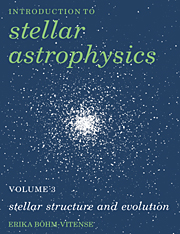Book contents
- Frontmatter
- Contents
- Preface
- 1 Introduction
- 2 Hydrostatic equilibrium
- 3 Thermal equilibrium
- 4 The opacities
- 5 Convective instability
- 6 Theory of convective energy transport
- 7 Depths of the outer convection zones
- 8 Energy generation in stars
- 9 Basic stellar structure equations
- 10 Homologous stars in radiative equilibrium
- 11 Influence of convection zones on stellar structure
- 12 Calculation of stellar models
- 13 Models for main sequence stars
- 14 Evolution of low mass stars
- 15 Evolution of massive stars
- 16 Late stages of stellar evolution
- 17 Observational tests of stellar evolution theory
- 18 Pulsating stars
- 19 The Cepheid mass problem
- 20 Star formation
- Appendix Radiative energy transport in stars
- Problems
- References
- Index
18 - Pulsating stars
Published online by Cambridge University Press: 08 January 2010
- Frontmatter
- Contents
- Preface
- 1 Introduction
- 2 Hydrostatic equilibrium
- 3 Thermal equilibrium
- 4 The opacities
- 5 Convective instability
- 6 Theory of convective energy transport
- 7 Depths of the outer convection zones
- 8 Energy generation in stars
- 9 Basic stellar structure equations
- 10 Homologous stars in radiative equilibrium
- 11 Influence of convection zones on stellar structure
- 12 Calculation of stellar models
- 13 Models for main sequence stars
- 14 Evolution of low mass stars
- 15 Evolution of massive stars
- 16 Late stages of stellar evolution
- 17 Observational tests of stellar evolution theory
- 18 Pulsating stars
- 19 The Cepheid mass problem
- 20 Star formation
- Appendix Radiative energy transport in stars
- Problems
- References
- Index
Summary
Period–density relation
In Volume 1 we saw that there is a group of stars which periodically change their size and luminosities. They are actually pulsating (the pulsars are not). When Leavitt (1912) studied such pulsating stars, also called Cepheids, in the Large Magellanic Cloud she discovered that the brighter the stars, the lpnger their periods, independently of their amplitude of pulsation. In Volume 1 we discussed briefly how this can be understood. The pulsation frequencies are eigenfrequencies of the stars. They are similar to the eigenfrequencies of a rope of length 2l, which is fastened at both ends but free to oscillate in the center (see Fig. 18. la). If you pull the rope periodically down in the center, first slowly and then more rapidly, you find that for a given frequency ν0 a standing wave is generated in the rope. For this frequency you need to put in only a very small amount of energy, much less than for the other frequencies, for which running waves are generated which interfere with each other and are therefore damped rapidly. The frequency ν0, which generates the standing wave, is an eigenfrequency of the rope. If you increase the amplitude of the wave you still find the same eigenfrequency ν0. If you increase the frequency further you again find running waves until you reach another frequency ν2, three times as large as ν0, for which another standing wave is generated. This wave has two nodes and a wavelength which is a third of the wavelength for the eigenfrequency ν0 (Fig. 18.1c).
- Type
- Chapter
- Information
- Introduction to Stellar Astrophysics , pp. 222 - 237Publisher: Cambridge University PressPrint publication year: 1992

